The LE
Sedge Pupa "Vesterelva"
by Leif Ehnström


This Pupa was born during a fishing trip
to the north of Norway in 2002. I and my two fishing friends were aiming for Arctic Char
but didn’t have such a good fishing as we were expecting.
One late evening we found that the fish
were feeding hatching pupas but we had some difficulty to have them take our flies even if
we tried different pupas such as Gold Ribbed Hares Ear, green or brown or whatever color
we found in our boxes.
Suddenly we found one pupa drifting past
us in the current and managed, not without trouble, to catch it. Now we found why we had
such a difficulty. It had a bright yellow-orange body and was rather large –
approximately 15 – 20 mm. The thorax was brownish.. Our flies were normal pupas
mostly in dull colors. I found a pupa in my fly box that was orange but a little too
small. However I put it on the leader and immediately I caught a fine shar. It was soon
followed by many while my friends still had a bit difficulty in getting the fish to bite.
The next day we tied several orange pupas
– a little longer and bigger on streamer hooks. Of course we had brought very little
orange tying materials on the trip, but took wool from sweaters and stuff to get near the
color of the pupa we had seen.
The following evenings we had a great
fishing in the little stream and caught us a fine catch of char.
When I came home again I started
experimenting and finally I got near the original with the fly I call – Vesterelva.
That’s Norwegian and means The Western River.
You can make a good pupa whatever way you
like, but the Vesterelva is so near the original you possibly can get. The shell of the
body, the wings, legs and even the eyes. A bit tricky to tie, but nice to have in the Fly
Box.
You can tie it in various colors and
various sizes. I’ve also tied some greenish variants that I have good faith in. The
tying method is my own because I like them to look realistic, even if the fish
doesn’t care. Feel free to use it or use your own method.
Tying description:
Hook: Partridge Long Shank Sedge
Hook 10 – 14
Thread: Brown (UNI 0/8).
Back body: Fiery Yellow SLF 75 % + orange Super Bright 25 % - amber coloured.
Rib: Plastic strip and 0,15 mm nylon line.
Legs: Grouse hackle.
Front body: Dark "Hares Ear dubbing" and plastic strip on the top.
Thorax: Brown or black raffia.
Eyes: Amnesia line.
Antennas: Elkhair
| 1.
The dubbing I use for the body is standard SLF in the color Fiery Yellow mixed with orange
Bright Light Dubbing. It gives me the yellow orange I found on the real pupa. |
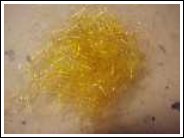 |
| 2.
The hook I use comes from Partridge in the UK and is called Long Shank Sedge hook. I use
it in sizes 10–14. |
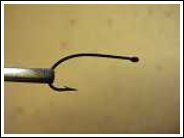 |
| 3.
I give the hook a little extra weight near the hook eye. A few turns of fine lead wire or
thin lead foil |
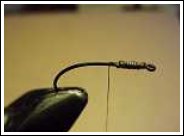 |
| 4.
I want to broaden the hook shaft by using nylon line. One strip on each side of the hook
will do. The nylon should be as thick as the hook shank, approx. 0,60 mm. |
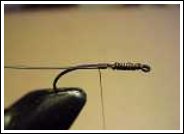 |
| 5.
Tie on a ribbing thread from thin nylon and a 2 mm strip of plastic or rubber to cover the
body and give it a transluscent effect. Let them hang from the end of the body for later
use. |
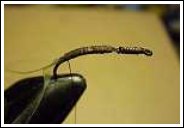 |
| 6.
Time to dub! |
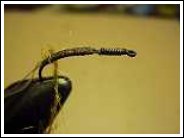 |
| 7.
This is the dubbed body of the fly. It should be a bit thicker in the middle. (Cigar shaped). |
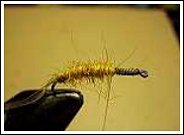 |
| 8.
Rib the body first with the plastic stripe and then the opposite way with the nylon to
hold it together. |
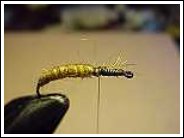 |
| 9.
First I dub a little brownish dubbing in front of the abdomen. The wing cases then are
made of doubled raffia strips tied backwards and then folded forwards. They should be
about half the length of the body. I also tie in some legs under the body. I use a Grouse
hackle and tie it as a "false hackle". |
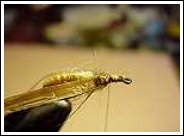 |
| 10.
Now I make the eyes from a piece of amnesia line. I hold it with my hackle pliers in the
middle of the 7 mm piece, and burn it with my lighter in each end to make the little
bulbs. |
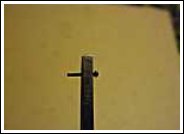 |
| 11.
I tie in the amnesia line x-wise and thus form the eyes of the pupa. I also tie in a new
strip of plastic to form the back of the thorax. I dub a little more of the brown dubbing
– for example Dark Hares Ear to form the rest of the thorax. I occasionally tie in
horns of stiff elk hair. |
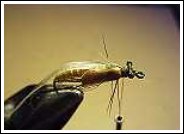 |
| 12.
Now I pull the plastic over the thorax. Tie it in both in front of the eyes and behind
them. I tie a couple of whip finish knots and laquer them. I color the back of the abdomen
and thorax with a brown filt pen and the fly is ready for use. |
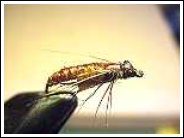 |
Leif
Ehnström © 2002
"LE flugor och flugfiske" (LE Flies and Fly Fishing)
http://www.LE-flugor.has.it |